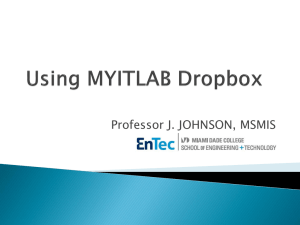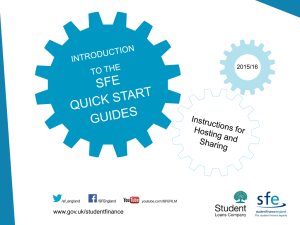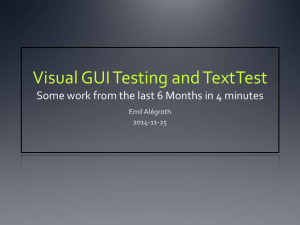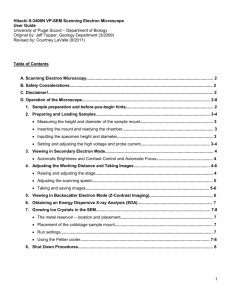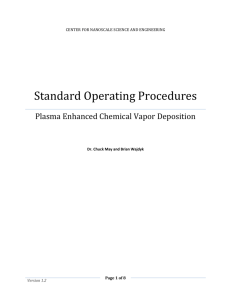Introduction to Operation of the XL
advertisement
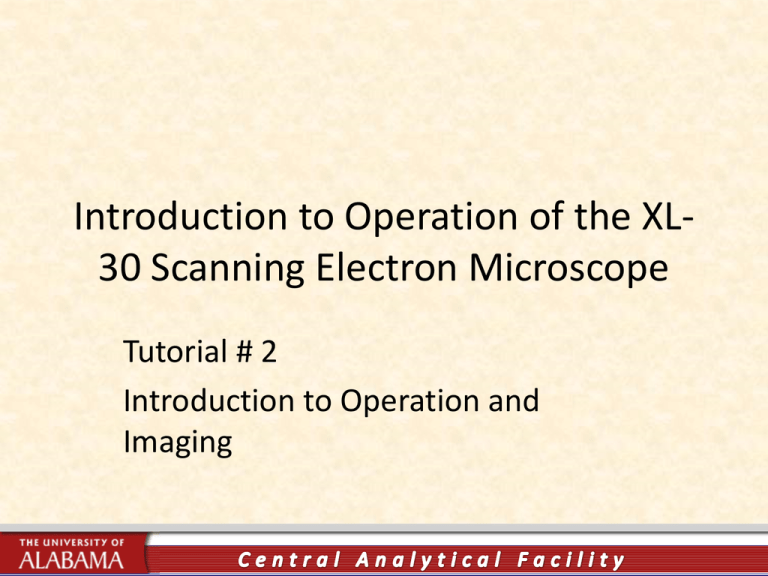
Introduction to Operation of the XL30 Scanning Electron Microscope Tutorial # 2 Introduction to Operation and Imaging Remember Purpose • Purpose of these tutorials is to enable the user to understand the basics of OPERATING the XL-30 to obtain Secondary Electron and Back Scattered Electron Images, and to obtain an Energy Dispersive X-Ray Spectrum. • Very little theory is given. • If the user’s requirements demand further instruction, he or she should seek further formal instruction. Prepare your sample • You should have your samples ready before using the instrument. Most samples are mounted on sample stubs like the one shown on the left. • If you use Carbon paint or some other liquid to attach your sample. LET IT DRY. • Non-conductive samples usually must be coated with a conductive material, e.g., gold, carbon. Log-In • You must have an account set in the CAF FOM to use this instrument. • You should also sign in the paper copy log book (until we discontinue). Overview The Column and Table Top • Do not lean on or place items on the Microscope table top. • The top is raised by air pistons when the column is under vacuum. This helps dampen any external vibrations that might be translated to the sample. Check Nitrogen • Nitrogen Gas – Open the valve on the bottle. DO NOT turn the needle valve on the gauge. • Liquid Nitrogen (see Liquid Nitrogen filling instructions) if you are going to do EDS analysis. Instrument On? • OFF button should be illuminated. • Vacuum button illuminated. • High Tension button may be illuminated. • The EDAX computer should also be ON. Open the XL30 Microscope Control • Generally the Microscope Control Program is up and running. If not, open the program from the Windows Program Manager. Load Your Sample – 1 • XL Control Program Upper Right – “Vacuum” the Pump button should be yellow meaning the chamber is under vacuum. – The Acc. Voltage button under “Beam” should be gray. – Left click the Vent button to start the vent sequence. The Vent button will turn yellow when the chamber is vented. Load Your Sample – 2 • It takes 30-45 seconds for the chamber to vent. • When the chamber is vented, pull the handle bar straight away from the column to open. • You will hear nitrogen still being vented into the chamber while you have it open. (But if you keep the chamber open for an extended period it will valve closed.) Load Your Sample – 3 • Using the tweezers load you sample onto the stage. • Make sure it is properly seated. (Remember to have your samples ready.) Load Your Sample – 4 - Height • Use the tool provide for height adjustment. This makes sure that your sample is under 10mm. If it is then your sample will not hit any detector when loading. Load Your Sample – 5 • Close the chamber door. Hold with on hand. • Click “Pump” in the Microscope Control. Vac OK • The chamber will proceed through a pump down procedure. • In about 2 minutes the “Vac OK” should appear beneath the Pump button. If it does not, STOP, something is wrong. Turn on the electron Beam • Click the kV button in the Beam section of the Settings Page • The Beam button will turn yellow, and you may see an image. No image • Go to a low magnification. • No image? Then, • Check to see that there is a current reading next to the kV button. • If no reading, get help. • If yes, then • Adjust Brightness and Contrast, or click Image! on the Menu bar. • Still no image, get help. I see something – Focus • You focus the beam (i.e., change the current in the objective lens) by holding the right mouse button and moving the mouse side to side. When you hold the right mouse button you see the cursor change to a horizontal double arrow. Moving the stage • The stage is not motorized. • Stage Center – – – – Approximate stage readings for the center of a stub: X = 74 Y = 76 Take care when changing the Z height. Do not crash your sample into the pole piece. – Remember that for X-ray analysis the Working Distance should be at 10. Move the stage to your area of interest • Make sure you are at a low magnification for initial moves. • Move X,Y, and Rotation as necessary. Getting a good image – 1 • Focus and stigmators • Focus as best as possible as described above. • The adjust the stigmators: – Press and hold the shift key while holding down the left mouse button. This will change the cursor from the double arrow to a hand that moves a horizontal and vertical line. – Adjust the stigmators to best image. – Then focus, then stigmators. Getting a good image – 2 • Experimenting with Accelerating Voltage, beam current (spot size), Working Distance, coating of the sample, and other factors. • You may have to work at obtaining what you want. Remember there must be sufficient intrinsic contrast. • Secondary Electrons for most images, but where you want to see chemical contrast, backscattered electrons may be best. Save and image • Save your images to the “aaa-data” directory on the d drive. • See separate tutorial for transferring data from the XL-control PC to the Dell. Shutdown • • • • • • Vent the chamber. Remove your sample. Pump the chamber down. Put all tools away. Pick up materials. Sign out. Troubleshooting • Do not troubleshoot the instrument without help. • If a problem occurs, describe it in detail when you log out of the FOM.


